Trending
Opinion: How will Project 2025 impact game developers?
The Heritage Foundation's manifesto for the possible next administration could do great harm to many, including large portions of the game development community.
In this Game Developer Magazine postmortem, Akihiro Imamura and Akira Yamaoka describe the making of their claustrophobic 2004 horror classic in grisly detail.
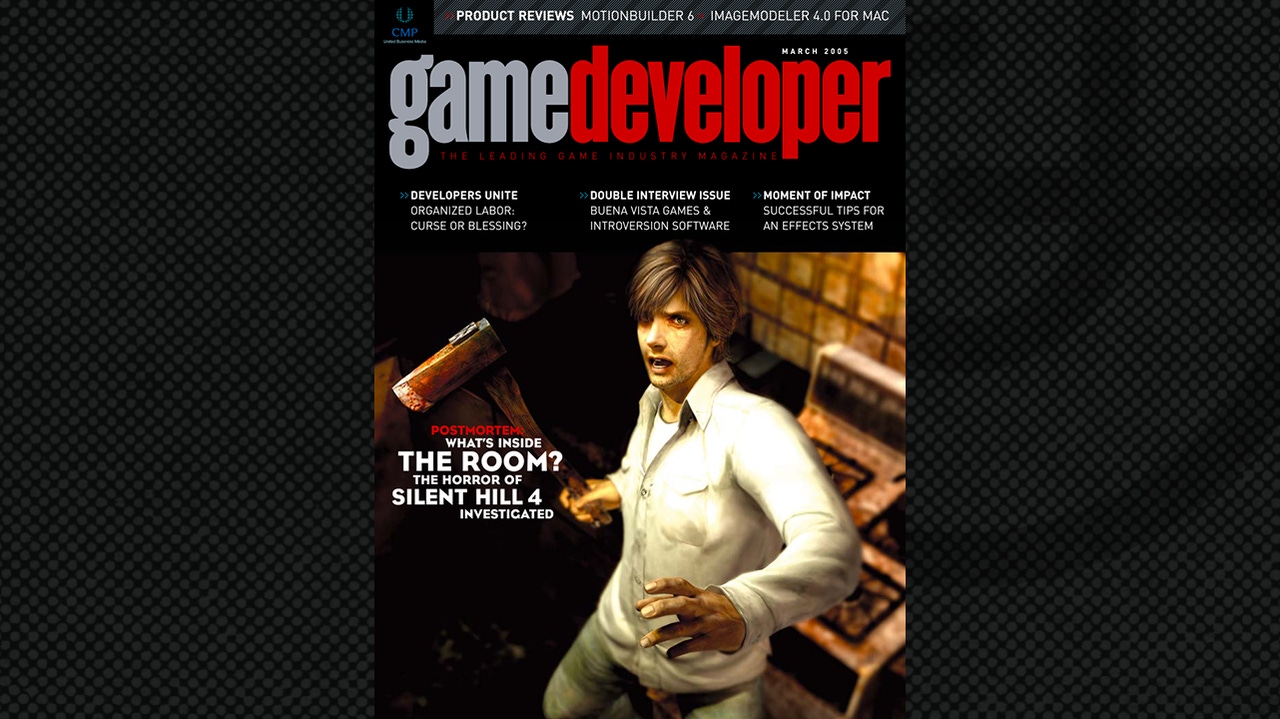
This postmortem of Silent Hill 4: The Room was first published in the March 2005 issue of Game Developer Magazine.
TO UNDERSTAND THE PROCESS OF CHANGE IN SILENT HILL 4: THE ROOM, we should first review the SILENT HILL series, in case you aren’t familiar with the franchise. The concept for the original SILENT HILL was simply a full 3D action game with a horror theme.
We wanted to do something within that genre for the PlayStation, which was still new hardware at the time. Given the limitations of the console, we could not render objects too far off in the distance, since it would be too taxing for the system.
But to capture the feel of a true 3D experience, we limited the field of visibility using fog and darkness, which worked really well for a horror game and has become a trademark for the series.
By restricting visibility with fog and darkness, we were able to instill a true sense of dread in people, something they instinctively feel when encountering an unknown environment. Then of course we added some lurking creatures, and some cool audio effects, and we wound up with something that was very scary. Of course creating the game was not as easy as that implies, but these were the basic building blocks.
To amplify this feeling of dread, we created an alternate world that was permeated with blood and rust. This visual style accentuated the horrific nature of that world by contrasting it with the standard game world. In essence, a dual world was created, in which one side was normal and the other was filled with every imaginable horror.
SILENT HILL was a work that ended up using the hardware's limitations to advance the horror of the game, and one that managed to come from a different perspective, when compared to other games released at the time. Even today, people still mention that SILENT HILL for the PlayStation was a favorite game of theirs. That makes us feel great— it’s very refreshing for other people to offer their views of our games, since everyone seems to like different aspects of them. We’re so close to our projects that sometimes it’s difficult to see what’s meaningful to other people.
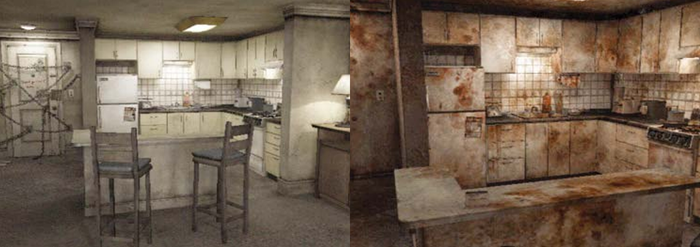
Transitioning between a “normal” reality and a horrific one heightens the sense of dread in THE ROOM. Images and caption via Game Developer Magazine, March 2005.
SILENT HILL 2 made the leap from PlayStation to PlayStation 2 while retaining the horror concept in the original game. This was a big endeavor because of the new hardware platform, and it required much more time and effort to develop, given the capabilities of the system.
We followed up that game with SILENT HILL 3, which further refined the graphics and sound, but there were no major changes to the game mechanics. As the creators of the series, we started to feel as though the gameplay was becoming stale. With that in mind, we undertook SILENT HILL 4: THE ROOM, for which preproduction began in fall 2001 and full production in spring 2002.
Even though the SILENT HILL 4 project was a proper sequel to the SILENT HILL series, our top objective for the game was "change." We wanted to make sweeping changes from the past titles and give players something new and fresh to play. Of course, changing something that has already proved its worth is always a risk, but we wanted to see what we could accomplish.
We took on the challenge of affecting change from many angles—from the horror concept to the game's subsystems. SILENT HILL 4 is very different from the previous SILENT HILL games, although to the average eye, it may still be just a horror game. The title emerged from our trials and errors while trying to achieve this change.
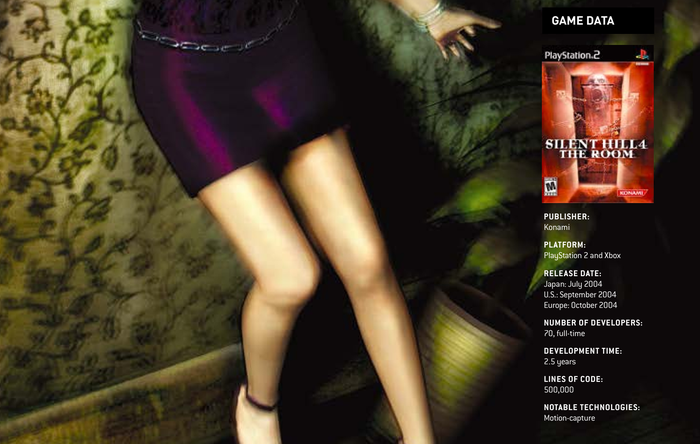
Image via Game Developer Magazine, March 2005.
While the SILENT HILL series lies firmly in the horror/action adventure genre, the root of the terror is not a fear of being attacked and killed by horrific creatures. Rather, it is a psychological terror of being slowly stalked and cornered by unknown beings.
It’s not really about the shock value, but much more of a deeper sense of foreboding; you know something is coming, but you don’t know when, and you can’t stop it.
Comparing the game to movies, the SILENT HILL series is closer to The Exorcist than Friday the 13th or A Nightmare on Elm Street.
In thinking about how it might be possible to realize a new type of horror in SILENT HILL 4 without destroying the foundations of the series, we arrived at the idea of the horror of being trapped within one's own room.
A person’s room should be a place of refuge and comfort. We felt that it would really be terrifying to become trapped in that sanctuary and to have that space gradually eroded through a succession of disturbing events. This was our main concept during SILENT HILL 4's development. We hoped that it could become a new type of horror game that people had not seen before.
Once we established the horror concept, we wanted to add innovation in how we projected it. If we wanted supernatural phenomena to happen in one's own room, we also wanted spiritual presences to appear as enemies.
We therefore created ghosts, a new type of enemy that inflicts damage on the player just by being nearby. Worse than that, they can come through walls, and even when knocked down, they rise again to relentlessly pursue the player
For Japanese people, the horror of ghosts is deeply entrenched in our culture. However, we weren’t confident that they would be frightening for people overseas, in America and Europe, for instance. In the end we agreed that the more general sensation of horror is shared by people worldwide, so we adopted our ghost as an enemy type after all. We believed that this enemy—an indefatigable being that ceaselessly pursues the player—is a very frightening presence to all, regardless of culture.
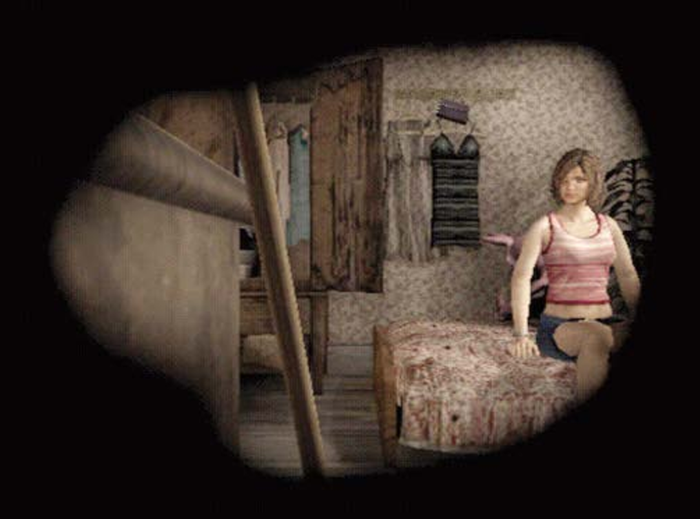
Voyeuristic elements are used to make the players feel uneasy. Image and caption via Game Developer Magazine, March 2005.
In developing any game, we hope to make the experience as real and immediate as possible for the player. One effective technique for doing so is using first-person perspective. This technique is one that we have long wanted to adopt for the SILENT HILL series, but using the first-person view for the entire series proved to be impractical. In terms of weaponry, the SILENT HILL games primarily featured objects used for clubbing enemies, which are very difficult to incorporate into a firstperson mode.
With SILENT HILL 4's room setting, though, we felt that it would be possible to use the first-person view to good effect. In practice, we believe that the technique sufficiently heightened the sense of being there, especially when supernatural phenomena occur. For the action sequences in the other world, the view shifts back to a third-person perspective, since it would be way too hard to fight enemies in first-person mode.
In past SILENT HILL games, whenever players needed to use an item or change weapons during battle, they could pause the action by opening the item menu, then leisurely select the needed items and weapons. We changed that with SILENT HILL 4. Item icons appear at the bottom part of the game screen to let the player use the items and switch weapons without pausing.
This system of putting the icons at the bottom of the screen was inspired by a similar feature found in many online games. The fact that the game time doesn't stop when selecting items was an improvement because it made for smoother gameplay and helped sustain the tension of the scenario.
Of course, SILENT HILL 4 is not an online game, so we still made it possible for the player to interrupt gameplay with the pause button to avoid needlessly distressing the player.
In many games, movie-like demo scenes are incorporated in key story junctures, and SILENT HILL 4 is no exception. We decided to add playable movie scenes, in which the hero could be freely moved. In those instances, there are no clear transitions to the scenes—we made the trigger an automatic one, in which the scene is set into motion when the hero approaches certain non-playable characters (NPC), who then begin conversing.
In actual play, there are instances when the NPCs seem to be talking to themselves. Even so, we felt that this approach heightened the player’s immersion. We thought that these sequences worked very well and brought a different feeling to the series.
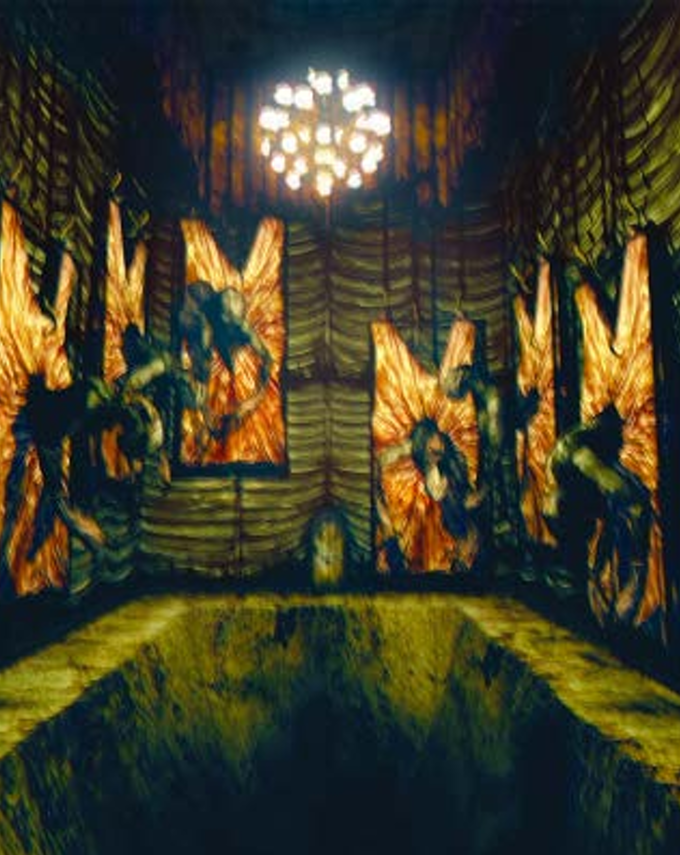
Dank interiors and terrifying vistas characterize SILENT HILL 4. Image and caption via Game Developer Magazine, March 2005.
It was disappointing that we couldn’t add any mid-level bosses simply because we didn’t have enough staff. We felt that the game stood well enough without them, but as we feared, it became a game that lacked catharsis. It has to be said—mid-level bosses are an important element of any action game.
By fighting mid-level bosses, the player experiences a sense of achievement and exhilaration at key points in the game. That tension compels players to keep moving forward. It’s really unfortunate that we weren’t able to budget the time for our programming staff to make even one mid-level boss. I think this hurt the game, as players wander through it without enough challenging fights at strategic points. It makes it difficult for the player to see what he or she has accomplished.
We wanted to introduce a new type of enemy by including ghosts, but many players said that rather than being frightening, the ghosts were merely exasperating obstacles. Even when knocked down, ghosts rise up immediately to resume their pursuit of the player. Players were irritated at constantly being on the run from them and as a result, were incapable of fully appreciating the beautifully rendered game environments.
In the latter half of the game, there are swords that can stun downed ghosts. While these swords allow the player to counter the indefatigable ghosts, there aren’t enough of them. The concept of invincible enemies wasn't a bad one, but in the case of the ghosts, we made them too strong.
In the retail version, the ghost becomes “unstunned” in 3–10 seconds. If we could change it, we would make the stunned time between 15 and 60 seconds, depending on which mode (easy, normal, or hard) the player is in, to give the player some respite. It also might have been nice to allow players to kill ghosts, but at a high cost. In any case, the ghosts turned out more annoying than scary for most people.

Akihiro Imamura (left) and Akira Yamaoka. Image and caption via Game Developer Magazine, March 2005.
At the start of the project, we planned to make the main character use club-like weapons for almost all the fighting. We also planned to make guns and ammunition very rare and special. We did so because we felt that one of the SILENT HILL series' more horrifying aspects is the brutal sensation of physically clubbing enemies. So we increased the variety of battering weapons, introduced a new system of charge attacks, and limited the availability of guns to only handguns.
However, when we developed the game with those weaponry changes in mind, ammunition was too rare, making players horde it for the final boss, thus rendering the gun a largely wasted weapon. We also discovered that battering weapons alone made fighting too difficult, which made it tough for the player to progress through the game. We quickly added more ammunition so the handgun could be used more regularly. For players of SILENT HILL 3, this was a big departure; that game had various guns and other types of weapons too.
With the SILENT HILL series, we had the policy of not displaying any gauges or icons on the game screen to enable players to become immersed in the world of horror. But we wanted to change the item selection process, so when we first started on the project, we clipped the top and bottom of the screen to make the playing field wide, and placed gauges and icons on the clipped black strips at the top and bottom.
However, with the top and bottom clipped, the game screen didn’t actually feel wide, just short. It made the screen feel cramped when controlling the character. Rather than adhering to policy, we gave priority to ease of play and decided to allow the placement of gauges and icons on the game screen. If we had gone with the widescreen mode, I think people would have complained that we weren’t using the entire screen!

Image via Game Developer Magazine, March 2005.
From the beginning, the SILENT HILL series has always featured so-called UFO endings that were intended for laughs. I think a lot of fans were looking forward to some kind of silly ending with SILENT HILL 4, but we were unable to put one in.
The UFO endings had been added to the past titles as jokes by staff who thought up something particularly funny and had the time to add it. However, no one came up with an amusing idea, and eventually we didn’t have enough time to include anything. I think that fans of the series were probably a little disappointed, although we did include a few different endings depending on how people played.
When making a sequel, developers usually try to include as many fresh ideas as possible; but fans of the titles will want the signature elements of the original game to reappear in the sequels.
In making SILENT HILL 4, we attempted to implement quite a few changes. As with all things, we had some successes, and we had some elements that in hind-sight, we could have improved. Also, some areas demanded more trial and error because the project was a new challenge, for example, having the player go back and forth between the room and the horrific world, and having the room gradually infected by the "other" world.
This approach was one that perfectly suited a representation of horror. But it lacked depth as an actual building block of the gameplay. We added problem-solving challenges, such as having to figure out that you need to use items brought back from the other world to the real world to complete a task. We tried to make various adjustments of that type to make it more satisfying for players to travel between the two worlds.
Before implementing this, it was just boring to go between the real world and the horror world, because it seemed too much like a chore instead of being fun. While we were faced with many challenges, developing SILENT HILL 4 was definitely gratifying to tackle.
No matter what the title, franchises are faced with the constant need to evolve. Otherwise, developers run the risk of turning people away from their games, due to the lack of innovation. (However, we also know that you need to identify and maintain certain sustaining elements of the original game when making a sequel.)
In the future, we will have to consider the possibilities of network gameplay for the SILENT HILL series, among other improvements. What that will entail we don’t know yet, but hopefully it will be something people want to try. Ultimately, we hope to keep providing the world with new entertainment by adopting new ideas for future games. Please look forward to what’s coming next!
You May Also Like